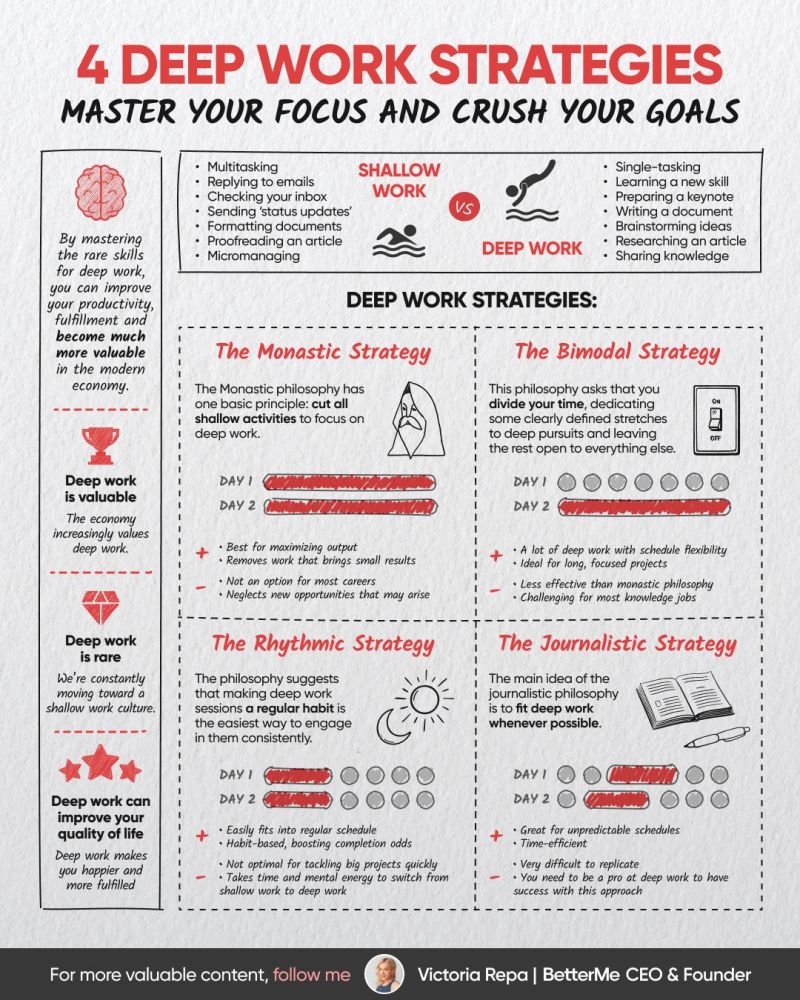Think Like a Genius: The Hidden Power of Deep Thinking
Have you ever wondered how some people seem to solve complex problems with ease, almost as if they have a secret superpower? These individuals, often labeled as “geniuses”, don’t just rely on luck or raw intelligence—they harness the power of deep thinking.
Unlike surface-level thinking, which skims over information quickly, deep thinking allows you to analyze, reflect, and connect ideas in a way that leads to breakthrough insights and innovative solutions.
Understanding how to unlock this type of thinking can transform the way you approach challenges, both in your personal and professional life.
Deep thinking is more than just pondering a problem; it’s a deliberate and focused cognitive process that engages critical faculties to understand issues at their core. According to psychological research, deep thinking involves careful reflection and the ability to synthesize information across different contexts.
This form of thinking has been linked to enhanced problem-solving skills, greater creativity, and improved decision-making.
This article will serve as your guide to unlocking deep thinking by exploring what it is, identifying the common barriers, and sharing proven techniques to cultivate it. By the end, you will understand how to leverage deep thinking to solve problems like a genius and elevate your cognitive abilities to new heights.
What is Deep Thinking?
Deep thinking goes far beyond the typical quick judgments or surface-level reflections most people engage in daily. It involves a sustained, focused, and intentional process of examining ideas, problems, or concepts from multiple angles.
Unlike shallow thinking, which often relies on snap decisions or gut reactions, deep thinking requires cognitive effort, critical analysis, and meaningful reflection. According to cognitive science, this type of thinking activates higher-order brain functions, particularly in the prefrontal cortex, where planning, reasoning, and complex problem-solving take place.
The distinction between deep and shallow thinking can be understood through the lens of Daniel Kahneman’s “Thinking, Fast and Slow”. In his work, Kahneman describes two modes of thinking: System 1, which is fast, intuitive, and automatic, and System 2, which is slower, more deliberate, and analytical.
Deep thinking largely falls under System 2, requiring effortful concentration and conscious reasoning. It’s this mode of thinking that enables people to connect disparate pieces of information, weigh evidence carefully, and develop innovative solutions to difficult problems.
Importantly, deep thinking is not an innate gift limited to geniuses—it’s a skill that can be developed and honed over time. According to neuroscientific studies, the brain’s plasticity means that with practice, individuals can improve their capacity for deep, reflective thought.
Deep thinking also involves emotional awareness and metacognition—thinking about one’s own thinking processes. This awareness helps individuals recognize their cognitive biases and avoid mental traps that can hinder objective analysis.
In essence, deep thinking is a comprehensive approach to engaging with information, problems, and ideas that goes beyond the surface to achieve deeper understanding and insight. Mastering this approach is key to becoming a more effective problem solver and creative thinker, which is why unlocking the secrets of deep thinking is so valuable.

This infographic outlines 15 practical steps for cultivating deep work, a vital habit for unlocking sustained focus and solving complex problems. From scheduling distraction-free time to clearing your mind, it provides a blueprint for accessing the kind of deep thinking geniuses rely on.
Barriers to Deep Thinking
Despite its clear benefits, deep thinking is often elusive due to a variety of barriers that prevent us from engaging fully with complex ideas. One of the most significant obstacles is the prevalence of distractions in our modern environment.
With the constant barrage of notifications from smartphones, social media, and emails, our attention is frequently fragmented. Research from Stanford University highlights how multitasking and frequent interruptions drastically reduce cognitive performance, making sustained deep thinking nearly impossible.
Another common barrier is mental fatigue. Just like muscles tire after physical exertion, the brain’s capacity for focused attention diminishes with prolonged effort.
Studies in cognitive psychology reveal that mental exhaustion can impair working memory and reduce the ability to engage in critical thinking tasks, leading to shallow or reactive responses instead of thoughtful reflection.
The pace of modern life also contributes to shallow thinking. The cultural emphasis on speed, efficiency, and instant gratification encourages surface-level engagement with ideas.
According to an article in The Atlantic, the rush to consume information quickly undermines the time needed for contemplation and deeper understanding. This “speed culture” is further exacerbated by social media platforms designed to maximize user engagement through bite-sized content rather than thoughtful discourse.
Technology, while beneficial in many ways, can paradoxically be a double-edged sword. The term “digital distraction” captures how constant exposure to screens and apps interferes with our ability to concentrate deeply.
Research from Scientific American explains that the habitual checking of devices disrupts our brain’s ability to enter states of flow — periods of intense focus and creativity that are crucial for deep thinking.
Recognizing these barriers is the essential first step toward overcoming them. By becoming aware of how distractions, biases, mental fatigue, and emotional factors influence our thought processes, we can take proactive measures to create environments and habits that nurture deep thinking.
The good news is that with intentional effort and strategies, it’s possible to break free from these obstacles and cultivate a mindset conducive to profound reflection and insight.
Techniques to Unlock Deep Thinking
Unlocking deep thinking requires more than just a desire to think better—it involves cultivating specific habits and techniques that foster sustained focus and intellectual clarity. Below are some of the most effective strategies backed by research and practiced by great thinkers.
Mindfulness and Meditation: One of the foundational practices for enhancing deep thinking is mindfulness. By training your mind to stay present and observe thoughts without judgment, mindfulness meditation improves concentration and reduces mental clutter.
Studies published in JAMA Internal Medicine have shown that regular mindfulness meditation can enhance cognitive flexibility and working memory, which are crucial for deep, reflective thinking.
Focused Reading and Reflection: Engaging deeply with challenging materials rather than skimming through texts promotes critical thinking. The practice of active reading—annotating, questioning, and summarizing—forces the brain to interact with the content more meaningfully.
According to Harvard’s Strategies for Deep Reading, slowing down to analyze and reflect on the material helps integrate new knowledge into your existing framework. Reflective writing afterward further consolidates understanding.
Questioning and Curiosity: Curiosity is the engine of deep thinking. By constantly asking “why,” “how,” and “what if” questions, you push your mind beyond surface explanations to explore underlying causes and connections. This technique, often referred to as Socratic questioning, encourages critical examination and discovery.
The Foundation for Critical Thinking provides resources on how cultivating curiosity sharpens analytical skills and opens pathways to innovation.
Journaling and Writing: Writing about your thoughts is a powerful way to clarify ideas and uncover new insights. Journaling allows you to process information, identify gaps in understanding, and organize complex thoughts systematically.
Research in Expressive Writing shows that regular writing practice enhances cognitive processing and problem-solving abilities. Whether it’s daily journaling or focused brainstorming sessions, putting thoughts into words deepens your engagement with ideas.
Eliminating Distractions: Creating a distraction-free environment is essential for deep thinking. This means turning off notifications, setting aside dedicated time for uninterrupted work, and even implementing techniques like the Pomodoro Technique, which breaks work into focused intervals followed by short breaks.
Digital detoxes, where you unplug from electronic devices for certain periods, are also highly effective. Studies published in the Journal of Experimental Psychology indicate that reducing multitasking improves focus and cognitive control.
The Feynman Technique: Named after the Nobel Prize-winning physicist Richard Feynman, this method involves explaining a concept in simple, clear terms as if teaching it to someone else.
This process exposes gaps in your understanding and encourages deeper comprehension. The Feynman Technique is widely used by students and professionals alike to master complex subjects and refine critical thinking.
Taking Breaks and Incubation: Sometimes, stepping away from a problem is the best way to find a solution. The brain continues to process information subconsciously during breaks, a phenomenon known as incubation.
Studies in neuroscience suggest that periods of rest or engaging in unrelated activities can lead to sudden insights or creative breakthroughs when you return to the task.
Real-life examples of these techniques in action include how Bill Gates famously takes “Think Weeks” to read extensively and reflect without distractions, and how Nikola Tesla reportedly used visualization and focused thinking to innovate.
By integrating these habits into your routine, you gradually train your brain to enter states of deeper focus and reflection, unlocking the kind of thinking that allows geniuses to solve complex problems with creativity and clarity.

This infographic highlights four deep work strategies that differentiate shallow tasks from truly focused, meaningful work. By adopting approaches like the Monastic or Bimodal Strategy, you can unlock deep thinking and tap into the genius-level focus required for breakthrough problem-solving.
Applying Deep Thinking to Problem-Solving
Deep thinking fundamentally transforms the way we approach problems. Rather than reacting impulsively or relying on surface-level assumptions, it encourages a methodical, strategic process that leads to innovative and sustainable solutions.
When you apply deep thinking to problem-solving, you shift from a mindset of quick fixes to one of long-term understanding and insight.
One of the first steps in applying deep thinking is reframing the problem itself. Instead of accepting the problem as it appears, deep thinkers challenge the initial assumptions and redefine the issue from multiple perspectives.
This approach is well-documented in design thinking, a problem-solving methodology used by leading companies like IDEO and Apple. By empathizing with stakeholders, defining core challenges, and brainstorming creatively, design thinking helps break down complex problems into manageable parts.
A practical framework for deep problem-solving is the IDEAL model, which stands for Identify, Define, Explore, Act, and Look back. This model encourages you to slow down and systematically analyze the problem, consider alternative solutions, implement the best one, and reflect on the outcomes.
Historical case studies showcase the power of deep thinking in solving complex problems. For example, Marie Curie revolutionized science through her methodical research and deep contemplation of radioactivity, leading to breakthroughs that changed medicine and physics.
Similarly, Steve Jobs was known for his relentless focus and ability to think deeply about user experience, driving Apple’s innovation in technology.
Deep thinking also helps shift your focus from reactive thinking to proactive thinking. Instead of responding hastily to problems as they arise, deep thinkers anticipate potential challenges and develop strategies to prevent them. This foresight is particularly valuable in leadership and management roles, where strategic planning is essential.
By applying deep thinking systematically, you transform problem-solving from a frustrating chore into a rewarding intellectual challenge. This mindset not only improves your ability to tackle current problems but also builds resilience and adaptability for future challenges, enabling you to solve problems like a true genius.
Cultivating a Deep Thinking Mindset
Developing a mindset geared toward deep thinking is essential for consistently solving problems with clarity and creativity. It’s not merely about applying isolated techniques; rather, it involves nurturing attitudes and habits that support ongoing intellectual growth.
One of the foundational aspects of a deep thinking mindset is intellectual humility—the willingness to acknowledge what you don’t know and remain open to new ideas. According to research published by the American Psychological Association, intellectual humility fosters curiosity and reduces defensive thinking, enabling deeper exploration and better learning.
Closely linked is the practice of growth mindset, a term coined by psychologist Carol Dweck. People with a growth mindset believe that intelligence and abilities can be developed through effort and learning. Embracing this mindset encourages persistence in the face of challenges and motivates you to seek out opportunities for intellectual development.
Another critical component is patience and tolerance for ambiguity. Deep thinking often involves wrestling with complex or uncertain problems without immediate answers. Developing comfort with ambiguity, allows you to stay engaged longer and explore more thoroughly, rather than settling for easy but incomplete solutions.
Creating a supportive environment is equally important for sustaining a deep thinking mindset. This includes surrounding yourself with curious, open-minded individuals who challenge your ideas constructively.
Studies show that intellectual communities and peer discussions foster deeper thinking and innovation, as noted in research from MIT Sloan Management Review.
By intentionally cultivating these attitudes and habits, you create fertile ground for deep thinking to flourish. This mindset not only enhances your problem-solving capabilities but also enriches your intellectual life, empowering you to approach challenges with greater insight, creativity, and confidence.
The Final Piece: Making Deep Thinking Your Daily Habit
Unlocking deep thinking is not just a skill but a transformative approach to life and problem-solving. By embracing deep thinking, you open doors to enhanced creativity, clearer decision-making, and a more profound understanding of complex challenges.
The journey toward cultivating this kind of thinking requires deliberate effort, patience, and the willingness to overcome common barriers such as distractions, cognitive biases, and mental fatigue.
As explored throughout this article, deep thinking thrives when supported by mindful habits like meditation, as explained in the Mindfulness Research Guide, as well as focused reading and reflective writing, which help sharpen introspection and critical analysis.
Techniques such as the Feynman Technique—which involves explaining complex ideas in simple terms to identify gaps in understanding—and structured approaches like the IDEAL problem-solving model offer concrete strategies to apply deep thinking in both academic and real-world situations.
Cultivating a mindset of intellectual humility and adopting a growth mindset equips you to remain open to feedback, learn from failures, and navigate ambiguity effectively. These qualities are essential in developing resilience and the mental agility needed to tackle today’s rapidly evolving challenges.
In today’s fast-paced, digitally distracted environment, the value of deep thinking cannot be overstated. Influential minds like Marie Curie and Bill Gates exemplify how deliberate, focused thought can lead to revolutionary outcomes.
Gates’s practice of taking regular “Think Weeks”—where he disconnects from technology to immerse in deep reading and reflection—underscores the importance of carving out time for uninterrupted cognitive processing.
Ultimately, unlocking deep thinking is about reclaiming the power of your mind to move beyond reactive responses and surface-level comprehension. It’s about engaging with the world more thoughtfully, making more informed decisions, and nurturing creativity that drives meaningful innovation.
Whether you’re striving for personal development, academic excellence, or professional mastery, deep thinking offers a powerful and often overlooked gateway to success.
FAQs About How to Unlock Deep Thinking: The Secret to Solving Problems Like a Genius
What is deep thinking?
Deep thinking involves focused, analytical, and reflective thought that goes beyond surface-level understanding to explore complex ideas and solve problems thoughtfully.
Why is deep thinking important?
Deep thinking helps improve problem-solving skills, enhances creativity, promotes better decision-making, and fosters a deeper understanding of complex issues.
How does deep thinking differ from shallow thinking?
Shallow thinking is quick, reactive, and often based on assumptions or immediate impressions, while deep thinking is slow, deliberate, and involves critical analysis and reflection.
Can anyone learn to think deeply?
Yes, deep thinking is a skill that can be cultivated with practice, patience, and the use of specific techniques like mindfulness, journaling, and active reading.
What are common barriers to deep thinking?
Distractions, cognitive biases, mental fatigue, stress, and a fast-paced lifestyle are some of the key obstacles that prevent sustained deep thinking.
How can mindfulness help improve deep thinking?
Mindfulness trains the brain to focus on the present moment, reduces mental clutter, and enhances cognitive flexibility, all of which support deeper reflection and concentration.
What role does curiosity play in deep thinking?
Curiosity drives the desire to explore, question assumptions, and seek new knowledge, making it a critical catalyst for deep, insightful thinking.
Are there specific techniques to unlock deep thinking?
Yes, techniques such as the Feynman Technique, Socratic questioning, journaling, and the Pomodoro Technique help train the mind to think more deeply.
How does journaling aid deep thinking?
Journaling allows you to organize your thoughts, reflect on ideas, and identify gaps in understanding, which fosters greater clarity and insight.
Can deep thinking improve problem-solving skills?
Absolutely. Deep thinking encourages thorough analysis, multiple perspectives, and innovative solutions, making it essential for effective problem-solving.
How can I create an environment that supports deep thinking?
Minimizing distractions, setting aside dedicated time, creating quiet spaces, and surrounding yourself with intellectually stimulating people all support deep thinking.
What is the Feynman Technique?
The Feynman Technique involves explaining a concept in simple terms as if teaching someone else, helping to identify gaps in understanding and deepen comprehension.
How does patience influence deep thinking?
Patience allows you to engage fully with complex problems without rushing to conclusions, enabling deeper analysis and more creative insights.
Is deep thinking useful in everyday life?
Yes, deep thinking enhances decision-making, improves communication, fosters empathy, and helps navigate complex personal and professional challenges.
How does technology affect deep thinking?
While technology offers access to vast information, constant notifications and multitasking can disrupt focus and reduce the ability to engage in deep thinking.
Can deep thinking be taught to children?
Yes, encouraging curiosity, asking open-ended questions, promoting mindfulness, and modeling thoughtful reflection can nurture deep thinking skills in children.
What is intellectual humility, and why does it matter?
Intellectual humility is the recognition of the limits of one’s knowledge. It fosters openness to new ideas and reduces biases, essential for deep thinking.
How do cognitive biases hinder deep thinking?
Cognitive biases, such as confirmation bias or availability heuristic, can distort judgment and limit the exploration of alternative perspectives necessary for deep thought.
How long should I practice deep thinking daily?
Even short, focused sessions of 20-30 minutes can be effective. Consistency is more important than duration to build and maintain the habit.
Can deep thinking improve creativity?
Yes, by allowing the mind to explore ideas thoroughly and make novel connections, deep thinking enhances creativity and innovation.
-Authored By Pragna Chakraborty





